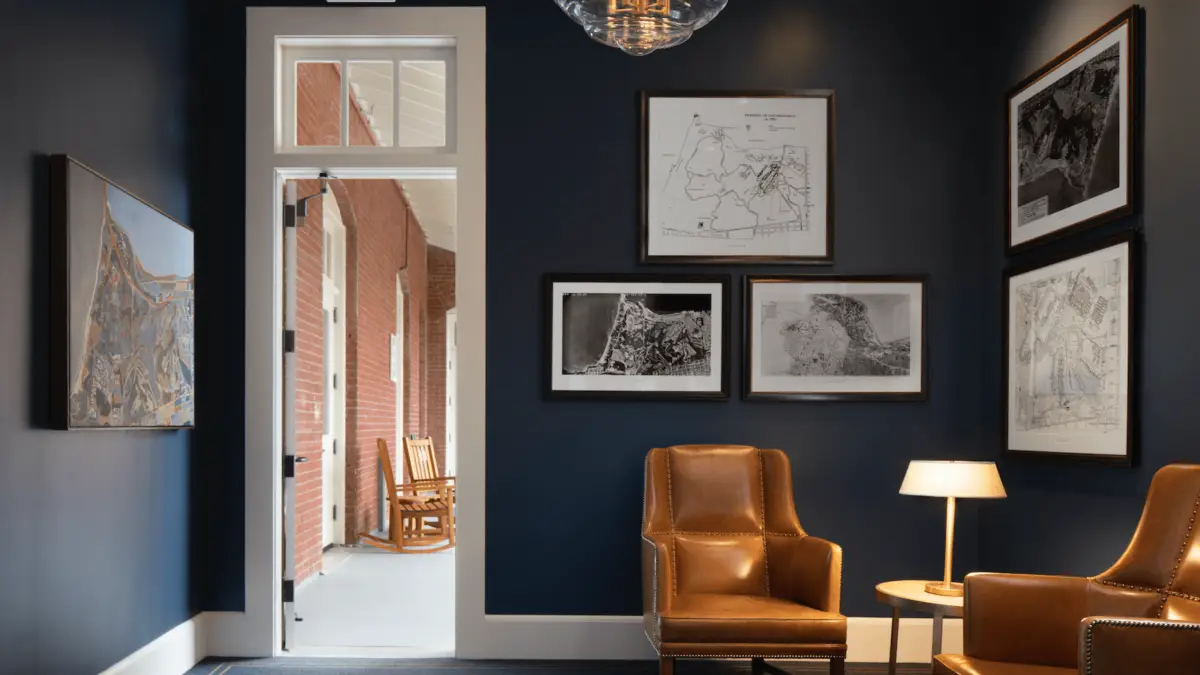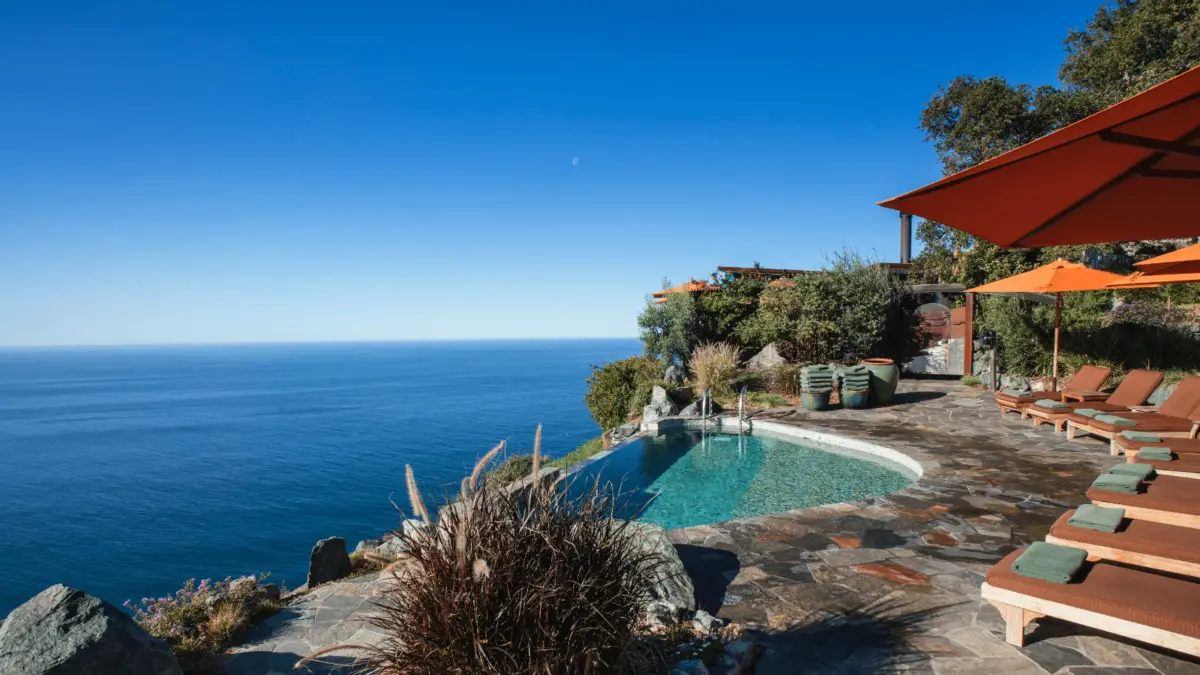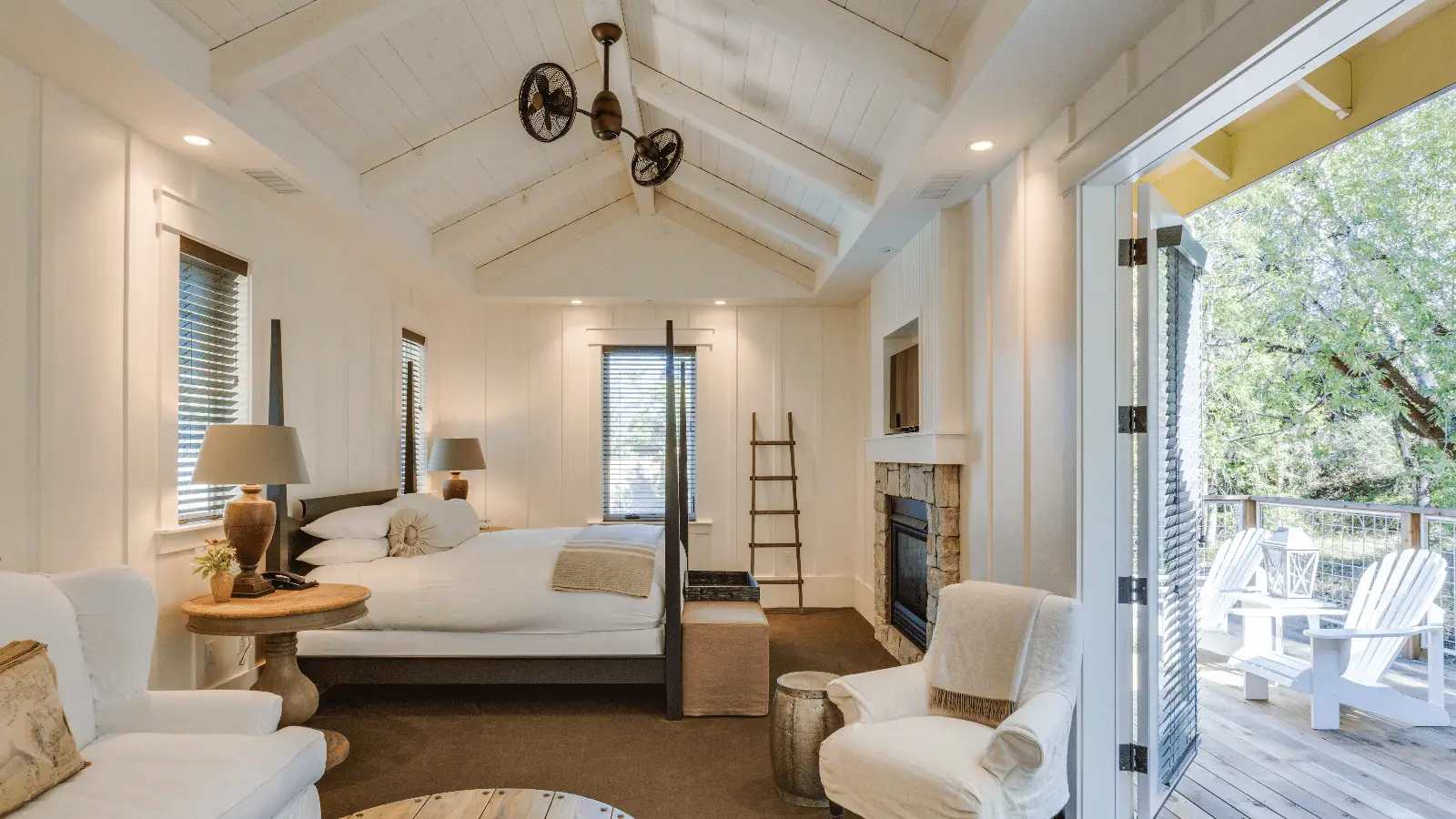In this new era of travel, getting away also means staying safe. Thus, small, boutique spaces that mesh easily with the great outdoors — rather than grande dames — speak to us. These five seemingly remote yet very accessible California hotels, inns and camps that we love, have fascinating histories and design backstories.
Feature image: Post Ranch Inn

San Francisco’s 1776 Presidio, established by Spanish colonial garrisons on Ohlone land, is as old as the U.S. Declaration of Independence and its green expanses are twice the size of Central Park, yet many residents — let alone tourists — have barely set foot in it.
That’s because this verdant, wooded enclave with restored wetlands and beaches abutting the Golden Gate Bridge was a U.S. Army base from 1847 until relatively recently. After it was decommissioned and turned over to the Presidio Trust in 1996, its historic officers’ quarters and barracks were only gradually converted to civilian use. Pershing Hall, a 1903 Georgian Revival-style dormitory for unmarried officers and now a U.S. National Landmark, was finally transformed a decade ago into the elegant, 26-room Inn at the Presidio. In its basement, you can still see the remnants of an even older wood-frame building that succumbed to fire, and books and graphics in the lobby illustrate the site’s history.

Now, the pet-friendly inn — which was the first neo-classical building in the Presidio and has hosted President Theodore Roosevelt — is quietly refined and seductively comfortable. Its original residents would have surely fought hard for one of its 17 new high-ceilinged suites and rooms with bespoke fireplaces, complimentary in-room breakfasts, wine, cheese and other amenities.
Yet, perhaps the inn’s greatest gifts are outdoors. Rocking chairs on the front porch invite you to sit and read for days without ever hearing the clang of cable cars; A back patio sports a fire-pit to gather outside on foggy evenings; And, the Presidio’s 1,500 acres include miles of hiking and biking trails across eucalyptus woods with peekaboo vistas and in situ works by artist Andy Goldsworthy. In the center of it all is a huge grassy parade ground for picnics with friends, while north across the famous bridge lie naturalist John Muir’s untouched redwood forests in Marin County and beyond it the Wine Country.

“The Inn is historic and it is a place to retreat,” says general manager Terry Haney. It now has two sister properties including the neighboring Funston House, an 1889 Victorian home with four individual bedrooms, and the larger 42-room Lodge at the Presidio in the nearby 1897 brick Montgomery Street Barracks. However, this distinctive hideout is also a starting point from which to see San Francisco’s many architecture and cultural hits.
For instance, within walking distance is the Bernard Maybeck-designed Palace of Fine Arts, a domed 1915 Beaux Arts folly where swans glide in a reflecting pond and brides regularly pose in front of its colossal neo-classical columns; And, Golden Gate Park’s 2005 de Young Museum designed by Herzog and De Meuron and the 2008 California Academy of Sciences building designed by Renzo Piano, Snohetta’s modern 2016 addition to Mario Botta’s 1995 Postmodern SFMOMA, the verdant elevated 2018 Salesforce Park by Pelli Clark Pelli Architects and PWP Landscape Architecture, and Olafur Eliasson’s 2019 Seeing Spheres sculpture at the shiny new Chase stadium, are all a short rideshare away. About $320 per night, plus tax.

Two-and-a-half hours south of San Francisco, the award-winning 40-room Post Ranch Inn along the Big Sur coast is probably one of the most original and exclusive hotels in the world. Known for the setting atop craggy cliffs overlooking the choppy Pacific and amid redwoods laced with ocean fog, its mystic atmosphere puts it high on every travel list.
However, when Post Ranch founder Mike Freed debuted it in 1992, the inn took off because of its modernist architecture, a series of quirky organic structures incorporated into a ridge overlooking the ocean, designed by architect Mickey Muennig.

Muennig, a self-described “gnome-like” Missouri native who studied under pioneer iconoclastic architect Bruce Goff, was drawn in 1971 to Big Sur’s famous Esalen Institute, a ’60s hippie retreat, and stayed on. He recently passed away at age 86, but his legacy of unconventional redwood, steel and glass shelters — undoubtedly influenced by Goff-contemporary architect Frank Lloyd Wright’s nature-inspired works — remains. Muennig’s eco-friendly hobbit-like buildings, all without any right-angled walls, seem to grow out of the ground that they stand on. Now a defining feature of the region, most of them are at Post Ranch in the form of tree houses raised on 9-foot high stilts, sunken earth houses covered with roofs of sod, lichen and wildflowers, and wavy redwood and corten steel dwellings.
Ten new sculptural structures — inspired by the originals — including two circular Pacific Suites with ocean views, Peak Houses that cantilever vertiginously toward the mountains, and Cliff Houses of curved wood, corten steel and glass were added in 2008. The Pacific Suites have faces exposed to the ocean and the sky but angled so neighboring guests can’t look in. Rooms that face the mountains also pay homage to the surroundings with a sophisticated rusticity fashioned with weathered redwood, stone and sheet metal.
Sierra Mar, a gourmet hotel restaurant in a wedge-shaped building with sheer glass walls overlooking the Pacific, is where breakfast is served. The top-notch restaurant can also oblige you with a packed lunch for cruising down the Pacific Coast Highway in a Lexus hybrid convertible that guests can reserve for free. Nearby attractions include thermal springs, hippie camps, spiritual retreats, beaches, State parks and the towns of Carmel and Monterey.

Muennig’s desire to reconnect to the earth seems to be the prevailing gestalt. Two cliff-top basking pools and a larger lap pool are prime spots to take in a pageant of sea-lions, whales and creatures that dip, soar and sail by; During a hike around the hotel grounds, endangered species such as the Smith’s Blue Butterfly, the California red-legged frog, the Western pond turtle, and the California condor might appear.
The small spa with four treatment rooms that offer a smorgasbord of unique treatments including sessions with a shaman, can take its show into individual rooms or balconies. All you have to do is ask. Free yoga and meditation sessions, and stargazing using the inn’s giant telescope are other ways to recharge. In lieu of mood-shattering TVs, rooms have Wi-Fi, a Sonos digital music system and a complimentary (non-alcoholic) minibar. Throughout, ubiquitous wood-burning fireplaces, radiant floor heating, outdoor showers or hot tubs, private decks, and organic bath products and linens all echo Muennig’s nature-forward mantra in this luxurious one-of-a-kind resort. About $1,650 per night, plus tax.

Catherine Bartolomei is a fifth generation Russian River Valley farmer and vineyard owner. Her great-grandparents settled on their 200-acre Forestville ranch in 1907, planted zinfandel grapes in 1911, and nearly a century ago built a large family house on the land where Bartolomei still lives today.
Two decades ago, she and her brother Joe wondered how they could host guests who wanted an insider wine country experience. Lacking the kind of buildings they dreamed of, they envisioned a different kind of farm and found just the place nearby — a 10-acre wooded farm very close to Healdsburg, with romantic peak-roofed Victorian-era clapboard buildings. The quintessential 1873 farmhouse and other structures were restored largely with elbow grease and in 2001 became the basis of their new venture, the Farmhouse Inn.

The first guests were accommodated in individual cottages with fragrant rose gardens. The old farmhouse, reserved for serving breakfasts, evolved into a farm-to-table Michelin star restaurant where their own produce and more recently even their Lost + Found pinot noir wines were served. Spurred by their virtually instant success — people liked being hosted casually yet elegantly by real vintners and staying at an authentic farm in the wine country — the Bartolomei siblings embarked on an ambitious expansion and upped their game.
In 2014, working with San Francisco-based resort designers SB Architects they added barn-like two-story buildings in back for nine suites and a long, airy spa structure on one side of the pool. With wide shutters, tall ceilings, Dutch doors and equestrian murals, the 3,000 square-foot stable-inspired spa has outdoor spaces off of each treatment room where guests can shower or lounge following their treatments. In keeping with the times the spa is now called the Wellness Barn, for a range of mind and body treatments that use unguents made from vibrant homegrown ingredients. In fact, the intimate gardens with fountains, picturesque vineyards nearby and poolside lounging are all conducive to a feeling of wellbeing. That’s why, on some mornings, Joe Bartolomei leads hikers through the surrounding woods across hidden trails, while others learn about farm yoga.

The new guest-suite barns, connected by a bridge, replicate the look and feel of the old but have vertical board and batten exteriors, with modern concrete floors and state-of-the art amenities. The old and new exteriors are all a buttery yellow, except for the spa that is painted white. The late Healdsburg designer Myra Hoefer also chose white for the interiors, and added signature slip-cased furnishings and leather and wood accents that feel pastoral yet chic. Hoefer’s firm, now helmed by her daughters, continues to refine the spaces at the Farmhouse Inn that all have either wood-burning or two-sided gas fireplaces, jetted or soaking tubs, saunas or steam showers, and private decks or courtyards.
The award-winning 25-room Farmhouse Inn has now reached the coveted Four-Diamond luxury boutique hotel status. Definitely expect aromatherapy toiletries, luxury robes, sensuous linens, flat-panel televisions, mini-bars and yes, eight-bottle wine refrigerators. After all, this unique enclave is in Sonoma where you will surely encounter must-have wines. About $760 per night, plus tax.

Luxury camping or “glamping” has become increasingly popular after the return of the great American road trip, and architecturally striking clubhouses for receiving guests often characterize the toniest campsites.
In that spirit, AutoCamp, a California-based hybrid campsite-hotel company, just added a twentieth century design icon to its clubhouse repertoire: the barrel-vaulted Quonset hut, composed of corrugated steel cladding bolted to curved steel ribs.
That’s notable because AutoCamp was founded in 2013 with the vision of using tents and vintage Airstream trailers as rooms, but went upscale after partnering with Airstream. As a result, its next camps near the Russian River and Yosemite National Park have factory-customized trailers with walk-in showers, luxe mattresses, furnishings and cooking accessories; and their clubhouses echo celebrated buildings by architects such as Mies van Der Rohe and Richard Neutra.

Now, the latest 25-acre AutoCamp just north of downtown Joshua Tree has two clubhouse pavilions housed in Quonset huts, set on opposite ends of a long concrete plinth. The larger 1,350-square-foot hut is enclosed for reception areas, a gathering nook and a store, but its glass back wall lets in breathtaking views of the mountains. It opens to a back bar, outdoor lounges, a pool area and paths to 55 individual Airstreams. The smaller of the two, lightly screened with slatted wood, is for outdoor meetings. A 660-square-foot rectilinear structure for a bathroom, a pantry and an office sits between the huts.
Prefabricated Quonset shelters first manufactured for the U.S. Navy in 1941 were easy to ship, assemble and disassemble in wartime terrain. They weren’t fancy. In postwar America they became ubiquitous, used as industrial and agrarian buildings and low-cost housing before falling out of favor.
So, in a sense, AutoCamp’s lofty, galvanized steel-and-treated pine Quonset structures, finely detailed with wood by Texas architecture firm, HKS, represent a Quonset comeback. Such prominent half-barrel forms were mostly seen in postmodern architecture decades ago. However, “we chose them as a nod to simple agrarian structures in the high desert,” says AutoCamp design director Will Spurzem, referencing salvaged examples displayed at the nearby Joshua Tree Outdoor Museum.

Inside the main pavilion, mid-century modern interior décor selected by San Francisco designer Shannon Niehenke of Narrative Design Studio complements the high-quality, large and small Airstreams that include similar furniture. “Everything we picked needed to be durable,” Niehenke says. Windstorms and hikers of all kinds — the camp is open to kids, pets and families — who have been out in the desert admiring flowering cacti and Joshua trees, bring in sand and mud underfoot. So, whitewashed, Baltic fir plywood lounge chairs designed by Oakland-based Alexis Moran, and arranged around AutoCamp’s signature mid-century style fireplace, are softened with cushions made of easy-to-wipe waxed tent canvas; Campaign-style folding and stackable furniture can be easily moved around and can even take a beating.
The concrete floors, and unfinished slatted wood on the curved interior walls will also patina over time. Throughout, natural rust and amber colors are intended to let the interiors extend visually into the outdoors. “My brief was to make the space unique to this location,” Niehenke explains. Joshua Tree also has a strong artist community so, naturally, she picked local art that abstracts the landscape. The designer walks a fine line between style and comfortable informality.
“AutoCamp is for people who want to explore all day, have a drink, make a meal outside,” she says. “It is not meant to hang out in all day, but we’ve designed it so you can.” About $200 per night, plus tax.

Long considered a sleepy road stop halfway between Los Angeles and San Francisco, the charming town of San Luis Obispo at the foot of the Santa Lucia Range in Central California — close to Hearst Castle — is slightly older than both those cities and is a destination unto itself. And, it appears that hoteliers Circe Sher and Paolo Petrone of Piazza Hospitality, whose Hotel Healdsburg helped to ignite a cultural renaissance in Healdsburg, thought so too.
“We really wanted a modern, beach-meets-ranch style hotel with a Southern California look there,” Sher said. “San Luis Obispo’s downtown is a walk-able, lively place. We wanted to introduce people to that and become a hub for the community.”

Their three-story 78-room Hotel SLO, a block away from the 1772 Mission San Luis Obispo de Tolosa that gives the town its name, opened shortly before the pandemic shut it down. When it rebooted, its indoor/outdoor public spaces — two street-access restaurants with generous outdoor rooms, a dining courtyard and pool sheltered within the U-shaped building, and a rooftop bar — intended to capitalize on the area’s warm weather, were exactly where people felt safe.
Now, even on a Monday night, the High Bar with grandstand views of the Nine Sisters — hikeable volcanic peaks that ring the town — gets filled with hotel guests, young professionals who work in tech, design and the area’s growing wine industry, as well as students and faculty from Cal Poly State University on the edge of town. It’s a kind of rooftop piazza with a youthful vibe.
Architect Chris Harrelson of the San Francisco firm Gensler, designed the airy modern stucco-steel-and-glass building. Interior designer Danielle Velasco who had worked with Sher on another Healdsburg hotel, picked warm wood features and mid-century modern furnishings for the lobby, outfitted the modest spa, decorated Ox + Anchor and Piadina restaurants, and helped curate the robust art collection showcased in rooms and on every floor. A round living wall by David Brenner, who also designed the one at SFMOMA, is incorporated into the signage. The fresh white guests rooms, with contemporary Scandinavian-style furnishings and super graphics painted above the headboards, have pops of color in pillow covers as well as commissioned art prints depicting present-day SLO landmarks as well as some from a now-disappeared Chinatown whose inhabitants built the town’s nineteenth century railway. “The façade’s terracotta tiles are a Chinese material,” Sher adds.

There are other histories to learn and Phoenix Books, a wonderful used-book store nearby, has a rich eclectic trove of books that remind you that SLO is a counter-culture college town of roughly 50,000 people with diverse creative interests. The first motel, the Frisbee, and the kooky Madonna Inn were all born there. Embracing the SLO life, many residents have become full-time cafe musicians, vegan shamans and surfing instructors at nearby Pismo Beach.
Food is a big SLO feature and interspersed between clothing and home decor boutiques along tree-lined Higuera Street, are choice eateries, brewpubs and bakeries tucked into nineteenth century storefronts. A picturesque creek also runs through town and you can follow it as it slips in and out of public parks, under footbridges, beside museums and into secret restaurant gardens.
On Thursday evenings a farmers’ market takes over the center of town and that’s where the hotel’s executive chef Ryan Francher finds organic ingredients and local cheeses. “It is heaven for chefs,” Calabria native Petrone says with a satisfied sigh. About $300 per night, plus tax.
Want more travel inspiration and tips from locals?
Follow us on Instagram @localgetaways!

